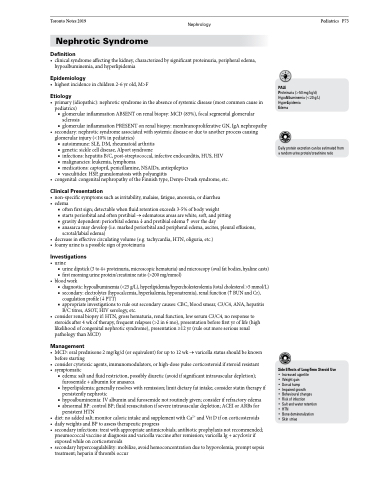Page 1107 - TNFlipTest
P. 1107
Toronto Notes 2019 Nephrology Nephrotic Syndrome
Definition
• clinicalsyndromeaffectingthekidney,characterizedbysignificantproteinuria,peripheraledema, hypoalbuminemia, and hyperlipidemia
Epidemiology
• highestincidenceinchildren2-6yrold,M>F
Etiology
• primary(idiopathic):nephroticsyndromeintheabsenceofsystemicdisease(mostcommoncausein pediatrics)
■ glomerular inflammation ABSENT on renal biopsy: MCD (85%), focal segmental glomerular sclerosis
■ glomerular inflammation PRESENT on renal biopsy: membranoproliferative GN, IgA nephropathy
• secondary:nephroticsyndromeassociatedwithsystemicdiseaseorduetoanotherprocesscausing
glomerular injury (<10% in pediatrics)
■ autoimmune: SLE, DM, rheumatoid arthritis
■ genetic: sickle cell disease, Alport syndrome
■ infections: hepatitis B/C, post-streptococcal, infective endocarditis, HUS, HIV ■ malignancies: leukemia, lymphoma
■ medications: captopril, penicillamine, NSAIDs, antiepileptics
■ vasculitides: HSP, granulomatosis with polyangiitis
• congenital:congenitalnephropathyoftheFinnishtype,Denys-Drashsyndrome,etc.
Clinical Presentation
• non-specificsymptomssuchasirritability,malaise,fatigue,anorexia,ordiarrhea • edema
■ often first sign; detectable when fluid retention exceeds 3-5% of body weight
■ starts periorbital and often pretibial → edematous areas are white, soft, and pitting
■ gravity dependent: periorbital edemaiand pretibial edemahover the day
■ anasarca may develop (i.e. marked periorbital and peripheral edema, ascites, pleural effusions,
scrotal/labial edema)
• decreaseineffectivecirculatingvolume(e.g.tachycardia,HTN,oliguria,etc.) • foamyurineisapossiblesignofproteinuria
Investigations
• urine
■ urinedipstick(3to4+proteinuria,microscopichematuria)andmicroscopy(ovalfatbodies,hyalinecasts) ■ firstmorningurineprotein/creatinineratio(>200mg/mmol)
• bloodwork
■ diagnostic:hypoalbuminemia(<25g/L),hyperlipidemia/hypercholesterolemia(totalcholesterol>5mmol/L)
■ secondary:electrolytes(hypocalcemia,hyperkalemia,hyponatremia),renalfunction(hBUNandCr),
coagulation profile (iPTT)
■ appropriate investigations to rule out secondary causes: CBC, blood smear, C3/C4, ANA, hepatitis
B/C titres, ASOT, HIV serology, etc.
• considerrenalbiopsyif:HTN,grosshematuria,renalfunction,lowserumC3/C4,noresponseto
steroids after 4 wk of therapy, frequent relapses (>2 in 6 mo), presentation before first yr of life (high likelihood of congenital nephrotic syndrome), presentation ≥12 yr (rule out more serious renal pathology than MCD)
Management
• MCD:oralprednisone2mg/kg/d(orequivalent)forupto12wk→varicellastatusshouldbeknown before starting
• considercytotoxicagents,immunomodulators,orhigh-dosepulsecorticosteroidifsteroidresistant
• symptomatic
■ edema: salt and fluid restriction, possibly diuretic (avoid if significant intravascular depletion); furosemide + albumin for anasarca
■ hyperlipidemia: generally resolves with remission; limit dietary fat intake; consider statin therapy if persistently nephrotic
■ hypoalbuminemia: IV albumin and furosemide not routinely given; consider if refractory edema
■ abnormal BP: control BP; fluid resuscitation if severe intravascular depletion; ACEI or ARBs for
persistent HTN
• diet: no added salt; monitor caloric intake and supplement with Ca2+ and Vit D if on corticosteroids
• dailyweightsandBPtoassesstherapeuticprogress
• secondaryinfections:treatwithappropriateantimicrobials;antibioticprophylaxisnotrecommended;
pneumococcal vaccine at diagnosis and varicella vaccine after remission; varicella Ig + acyclovir if
exposed while on corticosteroids
• secondaryhypercoagulability:mobilize,avoidhemoconcentrationduetohypovolemia,promptsepsis
Pediatrics P73
PALE
Proteinuria (>50 mg/kg/d) HypoAlbuminemia (<20 g/L) HyperLipidemia
Edema
treatment; heparin if thrombi occur
Daily protein excretion can be estimated from a random urine protein/creatinine ratio
Side Effects of Long-Term Steroid Use
• Increased appetite • Weight gain
• Dorsal hump
• Impaired growth
• Behavioural changes • Risk of infection
• Salt and water retention • HTN
• Bone demineralization • Skin striae


